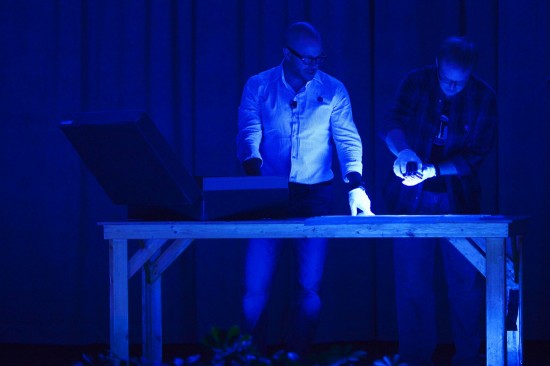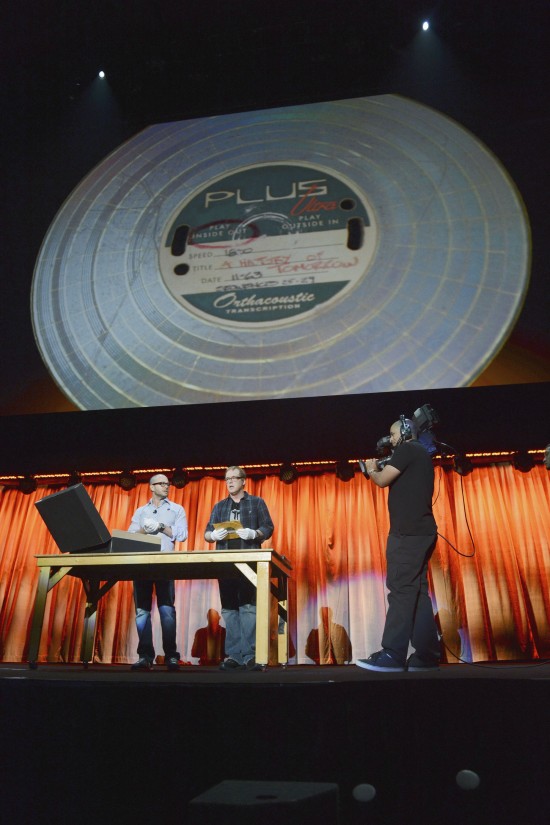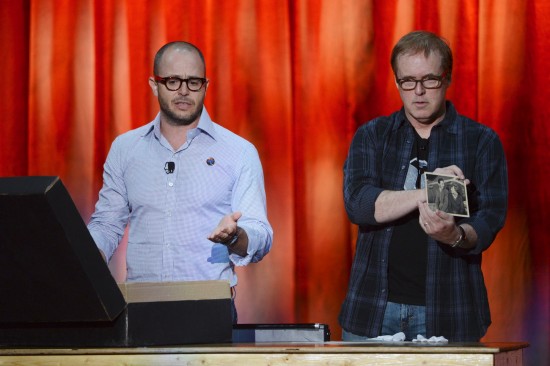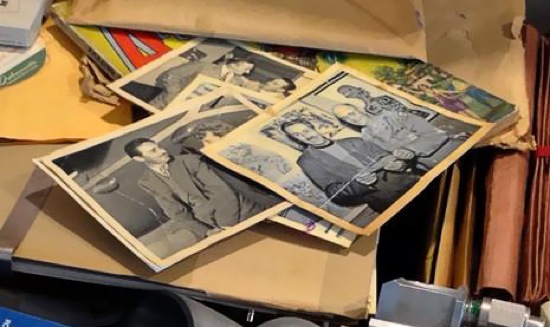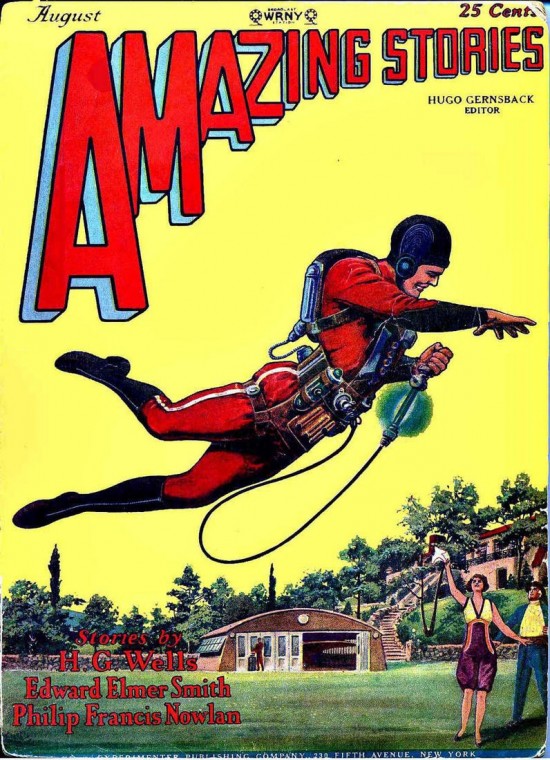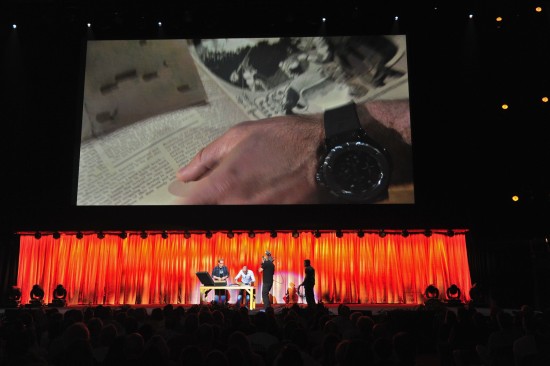Tomorrowland: Everything We Learned About The "1952" Box
This weekend at D23 Expo, director Brad Bird and writer Damon Lindelof finally gave the world a glimpse into the mystery box of their new film Tomorrowland. On stage, they literally unboxed the mystery, a 1952 box found inside the basement of the old animation building at Walt Disney Studio. The box and the contents serve as the inspiration for the new film. We wrote about the presentation here, but thats not the end of it. As the presentation came to a close, Bird and Lindelof announced that we'd all be able to get an up close look at the contents of the box at a newly constructed/unveiled booth on the show floor.
We spent two hours waiting to tour the booth with plans to give you guys a virtual look with a photo gallery — but Disney security was out in full force and not allowing ANYONE to take ANY photos. So after the jump, we do have something, information we learned about the contents of the box from the booth, including select transcripts of the audio tour from the booth. We have also included some images from the presentation released by Disney ad closeups of the box's contents from Bird and Lindelof's earlier tweeted photos.
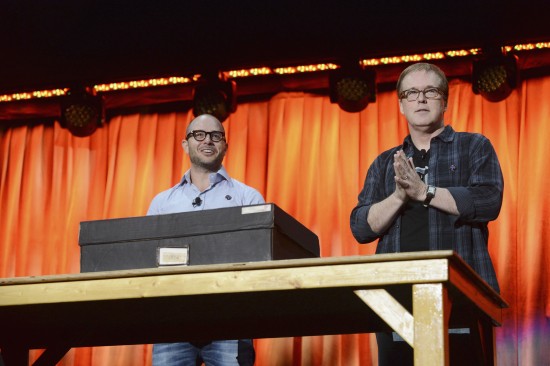 The Legend Behind The "1952" Collection
The Legend Behind The "1952" Collection
Under the old Animation building on the Burbank, California Walt Disney Studios lot is "a labyrinth of corridors recessed with alcoves and cupboards, connecting a series of closets, storage cages, and boiler rooms" and a place which used to be referred to as "The Morgue". Used as storage for artwork produced by Disney artists and stray artifacts. Many lost Disney artifacts have been rediscovered in this location. In 2003, a Pinocchio marionette, used by animators of the 1940 animated classic for animation reference, was found in "a custom-made plywood cabinet stashed in a dusty nook." A series of musician maquettes were used in the creation of Fantasia were also discovered in the space.
Now the legend behind the box which is the inspiration for Tomorrowland suposedly began in the summer of 2008, when maintenance workers cleaning out the basement discovered dozens of boxes in a locked room once owned by the titles department of the movie division. Most of the boxes contained a random assortment of film cells, which were immediately sent to Disney Archives and the company's other libraries.
But the contents of the cryptically marked packing box in this display case never reached Disney's history keepers. For this peculiar potpourri of reference material, concept art, photos, memos, books, comic books, newspaper clips, blueprints, machine parts, props, and more speaks to a creative history as odd and unverifiable as fiction. Yet together, the collection expresses values that were fundamentally true to Walt Disney himself: The dreamy fascination with space, technology, and exploration; the drive to create innovative forms of entertainment; and the desire to harness the power of imagination to cultivate new ideas that could build a more vibrant and vital future.
The box, marked with the labeled "1952" served as inspiration for Tomorrowland.
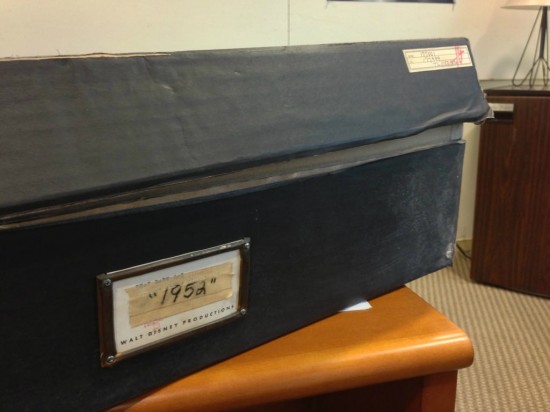 Damon Lindelof: "To be able to collaborate with someone like Brad Bird on a scifi project titled Tonorrowland is literally a geek dream come true. That this project should coincide with the discovery of this treasure trove of wonderful and weird stuff just oozing with Walt Disney's optimistic view of the future is an extraordinary windfall. Wondering what it all might mean has enriched our creative process and even inspired ideas for characters, story, gadgets and sets in the movie itself. Wether all of this is legit or not is really besides the point for us. Although I for one am dying to know. All that matters is that this box captured our imagination, and we hope it captures yours too."
Damon Lindelof: "To be able to collaborate with someone like Brad Bird on a scifi project titled Tonorrowland is literally a geek dream come true. That this project should coincide with the discovery of this treasure trove of wonderful and weird stuff just oozing with Walt Disney's optimistic view of the future is an extraordinary windfall. Wondering what it all might mean has enriched our creative process and even inspired ideas for characters, story, gadgets and sets in the movie itself. Wether all of this is legit or not is really besides the point for us. Although I for one am dying to know. All that matters is that this box captured our imagination, and we hope it captures yours too."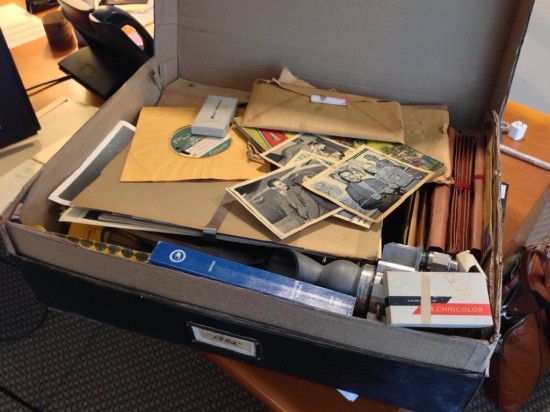 The World's Fair
The World's Fair
The Walt Disney Company had a significant presence at the 1964 World's Fair. Several iconic Disney attractions made their world debut at the fair, including Great Moments With Abraham Lincoln and It's a Small World After All, which were later relocated to Disneyland where they remain today.
Disney's other contributions to The Fair included:
From the audio tour:
These exhibits were suffused with Walt Disney's personal, altruistic form of futurism. For Disney, the concept meant human beings working collaboratively in a never-ending labor to produce new ideas and new technology that could engineer a better, constantly improving world for all. His passion for future-dreaming, future-building and future-fun manifested itself many ways, too, from the Tomorrowland section of Disneyland to his EPCOT ambitions and more. The box that has inspired Tomorrowland contains materials that speak to almost every aspect of Disney's futurism. However, the box is, at best, an unreliable narrator to its own significance. Among the many questions begged by the "1952" collection: Is this just a bunch of random stuff thrown together? Or do these items share a common, meaningful purpose, perhaps elements of some heretofore unknown Disney endeavor? Our inquiry into the matter begins with blueprints for Disney attractions at The 1964 New York World's Fair, and one set of plans in particular...
The 1952 box contains a stack of blueprints which includes early plans for Walt Disney's "It's A Small World" attraction for the World's Fair. This is the only blueprint known to exist which differs from the ride as it was built in New York, featuring "an alternate vision of the climactic set piece" which includes a miniature Eiffel Tower. Hidden in the blueprint is plans for another structure which would have been built below the pavilion.
This part of the blueprint can't be seen with the naked eye. The designs for the lower level only become visible when you shine a Wood's black light lamp on the paper, at a frequency prescribed by a handwritten instruction scribbled near the center of the blueprint. The access point to this underground space is not shown, and its purpose remains unclear. However, other notes suggest it might have been a large theater that used projection technology and an interconnecting group of screens not unlike the "Corridor of Mirrors" section of another Disney-produced World's Fair attraction, "Progressland."
There is no evidence to suggest that this proposed underground space was ever built but writer/producer Damon Lindelof wonders "what if?"
"A secret room, a secret movie theater, a secret ride inside a ride — how cool is that? If that didn't happen in 1964 then I call upon every Disney fan to lobby Bob Iger to make it happen now. Seriously, this was exactly the thing that made the box so exciting to us. It's why we let is inspire our creativity. What was the secret basement supposed to be? How did it fit within the larger goals and ambitions of Disney's work at the Worlds Fair? Brainstorming the answers to these questions led to some really cool ideas. At least, we think they're cool."
Trylosphere
Another item found in the box is something called a Trylosphere, which to my google searching ability, doesn't exist.
[The Trylosphere] evokes two iconic structures of The 1939 World's Fair, The Trylon and Perisphere. They can be seen on another item from the box, a ticket to The Fair. The Trylon and The Perisphere are iterations of architectural motifs that have been intrinsic to World's Fair design for decades and the history of art and architecture for much, much longer. The Trylon was a 610-foot tall spire. The Perisphere was 185 feet in diameter and held a massive diorama depicting "Democracity," an automated high tech metropolis. Neither The Trylon nor The Perisphere exists today. They were both scrapped during World War II so their material could be used to make armaments.
Called "The Trylosphere" according to a label affixed to its faux cherry wood housing. The same plate dates the object to 1962. At first glance, you might think "The Trylosphere" is simply a symbolic model of The Trylon and Perisphere, and a rather crude one at that. But there are some notable differences. For starters, the proportions are all wrong, with either the copper spire being too big or the copper sphere being to small, depending on your perspective. And then there is the cord and its bizarre six-prong plug, suggesting that "The Trylosphere" is actually an electrical appliance. Another label on the protective sheath includes a pictogram that shows the ball levitating above the point of the spire. There's also a code of dots and dashes – instruction, perhaps, for how to activate "The Trylosphere." While it's possible that "The Trylosphere" was created as a prop or model for an unspecified Disney production, Scott Trowbridge of Walt Disney Imagineering says he would love to see it work as the device it was designed to be.
T-Land TV
In the mid-1950s, Walt Disney produced a series of specials devoted to space, technology and scientific progress for the weekly Disneyland tv series on ABC.
The "Tomorrowland" shows were directed by an animator who shared Walt Disney's passion for futurism: Ward Kimball. Serving as consultant was a renowned rocket scientist, Werner Von Braun, a key architect of the country's space program. The "1952" collection contains scripts, storyboards, and Photostats of original concept art from the "Tomorrowland" series. There's also a memo describing several other science factual programs that were never produced or aired. These pieces seem connected to another peculiar item that deserves more detailed exploration...
Found in the box is a 9-inch disc that resembles an old Phonovision record, but is apparently "an experimental form of video storage technology similar to the laserdisc." The disc was dated "November 1963." The audio tour at D23 Expo claims that Damon Lindelof and Brad Bird brought in visual effects producer Tom Peitzman (Alice In Wonderland, Mission: Impossible — Ghost Protocol) to figure out a way to extract data from the disc. His team supposedly found "a never-before-seen piece of Disney animation from the early sixties." But problem is the content on the disc had been severely damaged. So who did Bird and Lindelof bring in? Data extraction specialists? The CIA? Nope... Pixar.
According to the story, Pixar Animation Studios were brought aboard to help whip "the animation into viewable shape." Of the seven minutes of content believed to be on the disc, Pixar has been able to recover or produce "three minutes of high quality footage." Of course, this is the footage that was screened at the D23 Expo live action film presentation. While the style of animation looked like something from the era, the quality of the animated was well above anything you would imagine. Most people who saw the footage at the presentation believe this part of "the legend" of the 1952 box to be completely created by Lindelof. But the tour isn't clear how involved Pixar is/was in the restoration, and others believe that they have completely recreated the rough animation which would theoretically explain the high quality.
The footage starts with humanity at the dawn of history, smashing together two rocks to make a fire and creative cave drawings, before jumping forward to ancient Greece and other cities. "There is no such thing as fate," proclaims a voice that resembles Orson Welles'. Fast-forward to the World's Fair in Paris in 1989. Images of Nikola Tesla, Thomas Edison, Jules Verne and Gustave Eiffel flit by, and they appear to be working together on a big, secret project. We also see pictures of various technological advancements including radios, cars, battleships, tanks, planes, electricity, the nuclear bomb, and the burning streets that followed the bomb. The implication is that technology is a double-edged sword — it has great potential for danger, but it also represents optimism for the future.
Yet those three minutes give us a good idea of the entire narrative. Entitled "A History of Tomorrow," the animated short begins with a moralistic fable about the pursuit of progress and the benefits – and folly – that can come from it. The choppiest section of the film tells the story of how Nikola Tesla, Thomas Edison, Jules Verne and Gustave Eiffel met at the 1889 World's Fair in Paris and began working on a project of an unknown nature that other brilliant minds continued after their respective deaths. A document placed inside the sleeve of the disc is a fragment of a longer letter; the date, unknown. Judging from the tone of the correspondence, the author of the letter was tasked with researching the plausibility of the Tesla/Edison/Verne/Eiffel summit. The legend of this meeting is just that: A legend. It is also highly unlikely that it ever happened: While Tesla, Edison, Verne and Eiffel all attended the Fair in the summer of 1889, and while Edison and Verne did indeed meet in Eiffel's apartment atop the Eiffel Tower on the evening of September 10, there is no historical evidence to substantiate the claim that all four men met to discuss, debate and even dream the shape and form of things to come. And yet, those who know this alleged tall tale find meaning within it. Edison and Tesla were bitter rivals in the war to bring electricity to the masses. The very idea that these enemies could muster the grace to put aside self-interest for a night to dream about a better future for the planet is extraordinarily inspiring – an example worth bringing from the realm of legend and making real in the world of today.
The animation ends with a voiceover which explains "And fellow traveler, that's why you were invited here. At long last we are building that tomorrow. A shinking beacon of hope. In just 20 short years, we will share this extraordinary place with the entire world. Would you like to see it?" Teasing a peak at a new futuristic city.
The box contains a book about "sophisticated science and mathematics of aeronautics and rocketry", but not a real book. It's one of those hallowed out books used to hide objects inside it. Inside is "a pin case the size of a hockey puck", and there is no pin inside the case, but instead a picture of a pin .
The box also includes a dozens of photographs of Walt Disney with various other people. While most of the pictures are authentic (or believed to be real), at least one of them is a proven forgery: a photo of Walt Disney and Amelia Earhart (obscured in the image above). Apparently the photo was created by putting Walt's head (from a 1956 photograph) on the body of movie star Cary Grant who posed with the aviation icon on the set of the 1935 film Wings In The Dark. According to the tour, no animators or imagineers employed by Disney during the fifties and sixties have any knowledge of this manufactured image . But it could have been created for a television project or a background prop for one of the tv episodes.
The box also contains an August issue of Amazing Stories magazine, which contains stories by Sci-fi authors H.G. Wells and Edward Elmer Smith.
The issue of Amazing Stories included in the "1952" collection was placed amid a thin layer of newspaper clippings which lined the bottom of the "1952" box. It was published in the summer of 1928 and contains work written by sci-fi luminaries H.G. Wells and Edward Elmer Smith, whose story "The Skylark of Space" – an early example of the so-called "space opera" – inspired the cover. It also includes a classic story by Philip Francis Nowlan entitled "Armageddon 2419 A.D." It tells the tale of a certain sci-fi Rip Van Winkle who fell asleep and woke up in a spectacular yet imperiled Tomorrowland 492 years in the future.
Clipped to the cover of the magazine was a piece of cardboard perforated with 30 holes (elongated rectangles). The top right corner of the card stock references page 422 of the magazine, the first page of the "Armageddon 2419 A.D." story. When you place the piece of cardboard over that page, words are visible in the slits:
"I have seen across the gap between I began practical penetration into the world. Secret retreats needed The perfection of mechanical labor and organization of industrial resources almost at hand."
But of course, the box has no other references to the purpose of this coded message. But who knows, maybe early imagineers were looking into new ways to code secret messages?
Jet-Man
The box also contains designs for a ride called "Jet-Man" by legendary Disney Imagineer Bob Gurr that would have "simulated the experience of soaring through the sky using a rocket powered jet pack."
As the director of special vehicle development, Bob designed some of the theme park's most iconic attractions, including "The Matterhorn" and "Autopia". He also helped to develop the original "Submarine Voyage" ride and the retired yet much beloved "Flying Saucers" ride. Bob imagined and engineered other wonders, too. He was deeply involved with Disney's World's Fair work as a member of the team that designed the "Magic Skyway" ride. Perhaps most impressive, Bob was the man who brought Abraham Lincoln back to life as an audio animatronic marvel. But there was one project that never made it beyond his drawing board: A ride called "Jet-Man"
Bob Gurr explains what happened to the Imagineering project:
"In 1966 for a new potential attraction at Disney they wanted us to simulate someone flying in space. Walt always wanted us to look at what we could do as an attraction that people could actually experience and a Jet man ride was a really obvious thing to do. Everyone has dreams of flying." .... "Awe I was really deep in working on that jet man ride . It was really gonna work really well. It was very straight forward, very simple and right in the middle of that job we got the bad news on a cold morning that Walt had died. They said Walt's dead, go home. Then a few days later were going to resume working on these attractions and then I got word that not only is Walt dead but the jet man ride was dead."
Machine Men
Walt Disney was fascinated with robots and part of Disneyland's legacy is due to the innovation of audio animatronics.
The "1952" collection includes many photographs of audio animatronic Abe and schematics and drawings for other, unknown audio animatronic figures. There is also a 12-foot long stretch of yellow tracing paper featuring robot-themed sketches and notes. Due to legal concerns and issues of taste, we can only show you the portion displayed here. The work is unsigned, though the style resembles that of early midcentury Disney animators and early Imagineers. The piece refers to an initiative called "Project Little Man, Phase Two."
It should be noted that "Project Little Man" was the inside company code name for Disney's original audio animatronics initiative.
City of Tomorrow
Other items in the box describe a proposed "city of the future" project, including a topographical map for what you may assume to be EPCOT but its not. The location in the plan is not the Florida site, and remains unknown. The map has a ripped-in-half overlay showing "a variation on Walt's idea of a radial city – an urban planning concept favored by futurist architects like Le Corbusier and Victor Gruen." Some of you may recall that one of Walt Disney's last ambitions was to build a city of tomorrow. Thats what he planned for EPCOT (Experimental Protoype Community of Tomorrow), which became something very different after his death. But the original plan for EPCOT was never realized.
Walt Disney: "I don't believe there's a challenge anywhere in the world that's more important to people everywhere than finding solutions to the problems of our cities. But where do we begin... how do we start answering this great challenge? Well, we're convinced we must start answering the public need. And the need is for starting from scratch on virgin land and building a special kind of new community that will always be in a state of becoming. It will never cease to be a living blueprint of the future, where people actually live a life they can't find anywhere else in the world."
Utopia?
The box also contains several science fiction novels, magazines and comic books, including:
Originally published in 1879, The Begum's Fortune blends elements of utopian and dystopian sci-fi to tell the story of two men who move to the same faraway land – otherwise known as Oregon – and build their own versions of utopia. One is an oppressive industrial engine devoted to manufacturing weapons of destruction. The other is an idyllic democratic community. The two cities come into conflict. At stake: The future of civilization. The Begum's Fortune is not as widely known as Verne's other novels. But it had an impact on the founders of a city in Argentina called La Plata, who modeled some aspects of their community after Verne's descriptions of Frankville. At the 1889 World's Fair, the founders of La Plata were honored for their visionary planning. Presenting them with a gold medal in the category of "City of the Future" was none other than Jules Verne himself.
The audio tour speculates that "Walt Disney and his collaborators might have used this material as inspiration or reference for known creative work and work still to be discovered."

